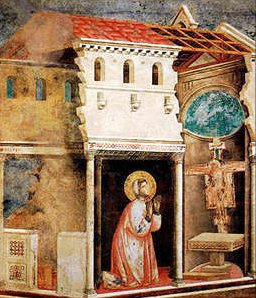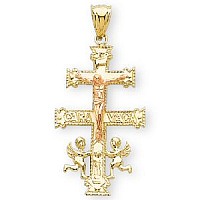|
I Corinthians
1:23-24 "But we preach Christ crucified: unto the Jews indeed a
stumblingblock, and unto the Gentiles foolishness: But unto them that
are called, both Jews and Greeks, Christ, the power of God and the
wisdom of God."
Every Catholic home should have a Cruficix hanging over the bed in each
bedroom, and, most importantly, at least one in a common area, such as
the Dining Room, Living Room, or Family Room. In addition, generally
speaking, Catholics should wear Crucifixes -- not empty Crosses (aside
from stylized ones of significance) -- around their necks. Why
Crucifixes instead of empty Crosses? Because, as did Paul, we preach
Christ crucified, and know that we get to the Resurrection through
the Cross, that we are called to pick up our own crosses and carry
them, offering up our sufferings in
imitation of Him.
Crucifixes may be gotten at any Catholic gift shop and are the perfect
gift for a newlywed couple as one can't have too many of them. You'll
find Crucifixes to be worn around the neck, some to be hung on walls,
some on stands to be placed on tables, etc. 1
You will see on some Crucifixes a skull and crossbones at the foot of
the Cross. Aside from symbolizing victory over death, this skull more
specifically represents the skull of Adam, said in Jewish and Christian
tradition to have been buried at Golgotha, where Jesus was crucified.
The Blood of Christ, the New Adam, redeems man, as symbolized by the
skull of the First Adam. I Corinthians 15:22, 45: "And as in Adam all
die, so also in Christ all shall be made alive...The first man Adam was
made into a living soul; the last Adam into a quickening spirit."
You also might see a representation of the titulus crucis --
the plaque marked with "I.N.R.I." which stands for "Iesus Nazarenus Rex
Iudeorum," the Latin initials for "Jesus of Nazareth, King of the
Jews." This inscription was written in Latin, Hebrew, and Greek and
placed at the top of Jesus' Cross according to Matthew 27:37, Mark
15:26, Luke 23:38 and John 19:19.
Crucifixes should be blessed by a priest and treated with great
veneration. Kissing a Crucifix is an indulgenced act.
There are a few Crucifixes and Crosses that stand out and should be
mentioned individually. The first of these is the San Damiano Crucifix.
San Damiano Crucifix

The San Damiano Crucifix was written by an 11th or 12th c.
Umbrian artist, and it came to adorn the chapel of San Damiano in
Assisi, Italy. It was before this Crucifix that Saint Francis of Assisi
was converted and received word from the Lord to repair His Church. The
Poor Clares, an Order of nuns founded by Clare of Assisi, a good friend
of St. Francis, took the Crucifix with them to San Giorgio in 1257, and
it now resides at San Giorgio's Chapel in the Basilica of St Clare of
Assisi. Now, look at the Crucifix more closely:

This Crucifix is
full of the Gospel events of His Passion. At the top, we see Our Lord
ascending into Heaven, toward the hand of His Father.
The Blessed Virgin and John, who was appointed to be her caretaker,
stand to Christ's right (our left). To Christ's left (our right) are
the Magdalen, Mary Cleophas (mother of James), and the Centurion
whose words we speak at Mass, "Dómine, non sum dignus, ut intres sub
tectum meum: sed tantum dic verbo, et sanábitur ánima mea" (Lord, I am
not worthy that Thou shouldst enter under my roof, but only say the
word, and my soul shall be healed). The little boy behind the Centurion
is the Centurion's son whom Jesus healed.
Also present are two other Roman soldiers, Longinus, who pierced Jesus'
side with a lance, and Stephen, who gave Him vinegar to drink (some say
this second figure is that of Pilate).
Beside His right leg is Adam, biting into the apple, and above Adam is
the rooster as a symbol of Peter's denial.
At the very bottom, under His feet, are 6 unkown Saints.
The transverse arm of the Cross is actually a tomb -- the empty tomb --
and at either end are Peter and John running toward it, being met by
the two groups of two angels
who let them know "He is not here."
The Pardon Crucifix

I have to mention this Crucifix because it is so lovely and
is relevant to one of my favorite Popes, Pope St. Pius X, who granted
these indulgences (not in the new
Enchiridion):
- Whoever carries
on his person the Pardon Crucifix, may thereby gain an indulgence.
- For devoutly
kissing the Crucifix, an indulgence is gained.
- Whoever says one
of the following invocations before this crucifix may gain each time an
indulgence: "Our Father who art in heaven, forgive us our trespasses as
we forgive those who trespass against us." "I beg the Blessed Virgin
Mary to pray to the Lord our God for me."
- Whoever,
habitually devout to this Crucifix, will fulfill the necessary
conditions of Confession and Holy Communion, may gain a Plenary
Indulgence on the following feasts: On the feasts of the Five Wounds of
our Lord, the Invention of the Holy Cross, the Exaltation of the Holy
Cross, the Immaculate Conception, and the Seven Dolors of the Blessed
Virgin Mary.
- Whoever at the
moment of death, fortified with the Sacraments of the Church, or
contrite of heart, in the supposition of being unable to receive them,
will kiss this Crucifix and ask pardon of God for his sins, and pardon
his neighbour, will gain a Plenary Indulgence.
On the back of
the Crucifix, on the transverse arms, are the words, "Father, forgive
them." On the long part of the Cross are the words, "Behold this heart
which has so loved men." The Sacred Heart is
shown where the two arms of the Cross meet.
Caravaca Cross or Crucifix
(a.k.a. "Cara Vaca" and "Cuernavaca")

This Cross takes its name from Caravaca (now known as Caravaca de la
Cruz), Spain, a town in the province of Murcia where, in A.D. 1231, a
priest was imprisoned by the Moors. Out of curiosity, his captors'
King, Abu Zeid, asked him to say Mass, but as the priest began, he
realized he didn't have the necessary Crucifix. As his captors grew
angry, the Patriarch of Jerusalem's pectoral cross was transported to
the priest through an open window, borne by two angels. Seeing this,
King Abu Zeid converted to the true religion.
The "Caravaca Cross," then, is the two-armed Lorraine Cross that is
used by Archbishops and Patriarchs. Some representations are
Crucifixes, such as the one above, and may show the angels that carried
the Cross, one on each side. The words "Caravaca" may appear on the
second arm of the Cross such that "Cara" is on one side, and "vaca" on
the other. This is a very popular Crucifix in Spain and Mexico.
Dagmar Cross

The name of this
Cross, which is pronounced "dowmer," is derived from the name of the
Queen who wore it -- Queen Dagmar of Denmark. She was born around A.D.
1189 in Bohemia, and became the wife of the Danish king, Valdemar II
("Valdemar the Victorious"), who reigned from A.D. 1202-1241.
When her grave was opened in 1690, this Cross was found around her
neck. Though Dagmar was a 13th century personality, the Cross is
believed to date to around A.D. 1000. At the center of the Cross is the
figure of Christ, and the four arms depict, starting at the top and
moving clockwise, St. John Chrysostom, St. John the Evangelist, St.
Basil, and Our Lady. The backside of the Cross is a Crucifix.
It is especially prized by the Danish people (because of Dagmar's
birthplace, the Cross was adopted by Lutherans as a symbol, too, sadly.
It is, though, in fact, a Catholic Cross originally, and now.).
Read also about the St. Benedict Medal
for information on the Crucifixes with the St. Benedict Medal embedded
-- a most powerful sacramental. See, too, see the page on Christian Symbols for the shapes of other
types of Crucifixes and Crosses.
Footnote:
1 Note on getting wearable
Crucifixes: don't waste your time getting pewter ones, even though they
are so inexpensive. They bend, break, turn black, etc.; get silver,
gold, wood, etc.
To clean a tarnished silver Crucifix, apply toothpaste to it and clean
it away with a sponge. If it is badly tarnished, make a paste of baking
soda and water and leave it on the Crucifix for a while. Then rub away
with a wet sponge. Another method is as follows: Put a sheet of
aluminum foil in the bottom of a pan and add 2-3 inches of extremely
hot water, some baking soda, and some salt. Add Crucifix so it sits on
the foil, and let it sit for a few minutes. Remove Crucifix, rinse,
dry, and buff with a soft cloth. Don't use this method with jeweled
crucifixes.
|
|

